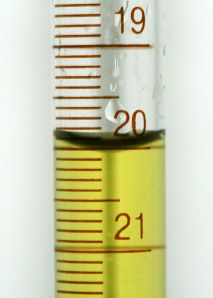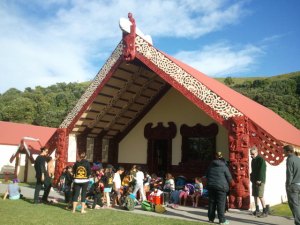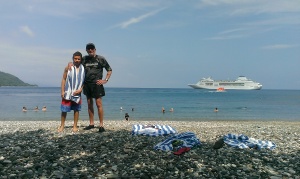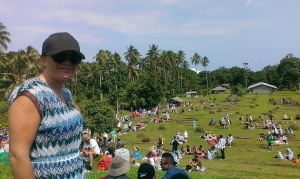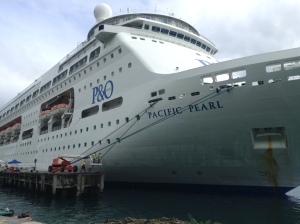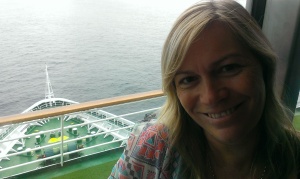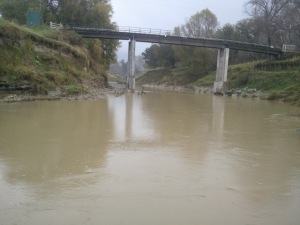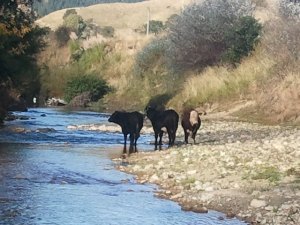Hamanatua Stream update
I know I haven’t been here for quite a while…I am back in the classroom and loving it, but extremely busy. Anyway, this weekend my sister, her children and myself ventured down to the all but dried up stream to explore. We were talking about eels and I mentioned a spot where I could always find a rather large eel, even in the driest of summer months. When we went down, and yes the spot was there and still had a small amount of water in it. When we looked closer we saw an abundance of inanga and then to our excitement, a number of small eels. We played around in there for some time and ended up finding about 7 small eels(to the absolute delight of Whai and Naaki). The water is stagnant and full of periphyton, the water colour is black and the smell is putrid. Is it called eutrophication? So on the upside, the rain is now coming down and with the cyclone prediction of severe wind and rain, it looks as though those eels and inanga will have some fresh water to refresh the gills. I also noticed water boatman swimming around and wondered what other macroinvertebrates may have been there.
Visit to Te Karaka Area School
Awesome visit to Te Karaka Area School last week. Thanks Karyn for letting me enjoy the facilatative learning centres. Great technology. An inspiration! Thanks to a post that I noticed on the ICT Facebook Group and a chance discussion with a friend that teaches here, I got the wonderful opportunity to visit Te Karaka Area School (previously Waikohu College). A quick email off to Karyn Gray (Principal) lead to an even quicker “absolutely, come and visit” reply. I got to observe the middle unit and the senior unit teach in a collaborative and independent manner using the latest technological advances in education – I’m talking IPads and Macs used with Google Drive (I think). I’m not sure exactly because they showed me a ‘free’ online community for their school but I can’t remember the name. I will find out and get back to you…because it was very comprehensive. The open learning spaces were designed so that each space can be used in ways that fit the learner and their learning needs. For example, an independent learner wanting quiet to concentrate, finds the space that matches, similarly a collaborative learner would use a discussion space. Well, I think this is how it all worked. I really need to get Karyn’s professional take on this, but it certainly meant that all students were engaged that I met with. Teachers were on hand to conference at any time…
Inside a classroom
Open Learning Spaces – linking pedagogy and classroom design states that the perceived benefits… looked like this, and it’s worth detailing them in full:
“• More flexible and creative use of instructional time that advantaged students;
• Knowing more about all the students and seeing different student strengths given the opportunity to view them in varied learning contexts;
• Greater shared ownership of students and student learning;
• Increased reflection on individual and collective teaching practices;
• More learning from and with colleagues about students and about teaching and learning;
• Increased collective expertise resulting in greater effectiveness with a variety of students;
• Decreased teacher isolation, increased support and feeling valued by colleagues;
• Itinerant teachers experiencing varied collaborative designs and strategies then being able to share those experiences and ideas across classrooms; and
• Having more energy and greater enjoyment from teaching.” (p. 317)
References
Woolner, P. (2010). The design of learning spaces. London: Continuum.
York-Barr, J., Ghere, G., & Sommerness, J. (2007). Collaborative teaching to increase ELL student learning: A three-Year urban elementary case study. Journal of Education for Students Placed at Risk, 12(3), 301-335.
Whangara School hosts a magical day
Friday 23 May
I had the absolute pleasure of visiting Whangara School with Murray Palmer. He has a long standing relationship with the school since Jay Love did his Royal Society Teacher Fellowship with him a number of years ago. Jay continues to serve as kaitiaki to his Whangara bound rivers and streams. Back in those days teacher fellows had a year to work on a piece of research. Jay delivered a poster on cultural indicators derived from his own community. I would like to post more about his work in detail but that will have to wait as I’m having a bit of trouble extracting that information from the RSNZ website. His wife Lisa Maniapoto also completed a teacher fellowship and I was able to ask her about her experience. This involved a trip to Hawaii to investigate waka and navigation. Pretty awesome. Another teacher from Whangara School, Nadia Hohipa also did her Teacher Fellowship, but like me, had a 6 months sabbatical. It was lovely to meet her and find out more about her own experience, very similar to my own. The only difference was that she shared her fellowship time with Cheryl Gomm from Awapuni School. Nice to have a ‘partner in crime’ I would say. So, it was a very cool experience to meet and share stories about our own varied experiences on our Teacher Fellowship journeys. Funny thing was that this wasn’t the best part of the day. Of course it was the kids! How captivating and captivated by all things science. Just lovely. I’m sure it had everything to do with the fact that they had a Noho Marae stay the evening before. Talk about whanaungatanga! A quick walk over the hill to the river mouth (just down from), set the scene for water testing (physico-chemical) and then in groups we descended to the rivers edge to fossick around for any evidence of water life. We found shrimp which was to be expected given the esturine environment. A feast for sea creatures – high in protein. I think a highlight for the students was watching as I did the dissolved oxygen test and had one of the boys help me to titrate. We even learned what the meniscus was…
Meniscus
The meniscus is the curve in the upper surface of a liquid close to the surface of the container or another object, caused by surface tension. It can be either convex or concave, depending on the liquid and the surface. Wikipedia
Here are some photos from our wonderful day…
Time for a holiday – destination Vanuatu
All work and no play makes Mrs Hannah a dull teacher…
After working through the holidays, I took time out with my family to head off for some well deserved R&R.
A short stop in Rotorua for a dance comp (my son, not me), leaving with a couple of cups in hand, time to watch the Rotorua marathon that my brother in law ran, then it was off to Auckland. Did I mention it was a cruise? Well the moment we saw the cruise ship we were awe-struck! It was then that I knew that we were going to have the time of our lives. We left a cold, rainy Auckland city for the balmy islands of Vanuatu. Champagne Bay (Espirito Santo), Pentecost Island (where they bungy with vines), and Port Vila. We missed out on visiting Mystery Island due to rough seas, so it still remains a mystery but it certainly didn’t affect our enjoyment of the whole experience. Here are a few pics of our holiday.
Was there any science discovery while I was on holiday? Absolutely! I have grave concerns for the coral reefs of the world and wonder why there was no real education around how to treat the reef when snorkelling. A fascination with the bungy jumping or land diving at Pentecost Island gave me insight in to how gravity pull and velocity is managed (ie how they don’t die on impact). The ceremony is only held at a certain time of year when the vines used are supple. Also, the platform that they jump from has a break deployed meaning that it takes the initial force before the strain of the vine, thereby reducing the force applied to the jumper. Here is a snippet from the Vanuatu Tourim website:
“Pentecost Island has become famous throughout the world for the land diving ritual (Nagol or N’gol) which occurs every Saturday between April and June. The ritual, which influenced the invention of bungee jumping by Kiwi AJ Hackett, sees local men and boys as young as seven jump from a 20 -30 metre high man made tower with only a vine attached to their legs. The tower itself takes locals five weeks to build using materials from the forest. The vines are carefully selected by jumpers who know that just 10 centimetres may be the difference between life and death.
Traveling to view this magnificent ceremony is a once in a lifetime experience. No words can express the feeling of the ground vibrating under the dancing and stomping feet of villages and the excitement of sitting beneath the tower waiting with unease for the diver to jump safely to ground. The awe- inspiring ceremony celebrates the yam harvest and is a fertility rite for men.”
Also, I experienced absolute wonderment and awe in seeing the absolute vast nature of the Pacific Ocean. No words can describe this – it’s breathtaking! Finally, I became concerned with the lack of infrastructure present in Port Vila – the rubbish is everywhere. This is probably a Social Science issue, but rubbish in the environment is a global issue. How could a people that so obviously treasure their land and way of life put up with this eyesore affecting their surroundings?
Anyway, the trip was awesome! The service, the island hopping, the cruising, food, entertainment, and facilities were second to none. Totally recommend it.
Freshwater Advisory Group Meeting
30 April
This was a real coup to be able to attend this meeting, so big thanks to Murray Palmer for asking on our behalf (myself and Vanessa Awatere). Ness is doing her Masters in relation to water quality and has a degree in Maori Research Methodologies.
I don’t want to go too much in to the detail (some of which went right over my head), but what was exciting for me was seeing all the representative factions discussing and deliberating on such an important topic. Topics on the table included:
- tangata whenua in relation to mauri, iwi management, and taonga species
- water allocation (that’s a biggy)
- water quality (obviously)
- environmental outcomes
The time went very quickly indeed, and the Chair, Pat Seymour ran a very tight ship. It was just very cool to see science taking a lead role in Council matters.
Leadership Assignment 1
Remember the Leadership Course in Dunedin that I went to? Well attached to this week are two assignments. They relate to your own leadership potential and the implementation of leadership initiatives when you return to school. You need to be brutally honest with yourself, your own ability, and the nature of your school community. On the course and subsequent readings, we consolidated understanding of a wide variety of leadership styles and best practise. We could choose from 3 assigned topics. I chose the following:
Linking leadership skills with improved student learning
Written report of Action Plan
QUESTION 2 – Dr Ross Notman
Linking leadership skills with improved student learning
The assessment will be divided into two sections:
(i) Oral presentation of Action Plan:
Deliver a 3 minute oral presentation on an Action Plan using the template provided, and receive feed-forward from the group.
Assessment critera:
Class members will be expected to demonstrate
- Understanding of the leadership skills they hope to use
- Clarity in linking those skills with intended outcomes for student learning at their school.
(ii) Written report on Action Plan:
Course participants will construct a more detailed written report about their Action Plan. In 1200 words (max), they will describe their Plan using the eight headings contained in the template.
Assessment Criteria:
- Critical self-reflection about their use of leadership skills
- Understanding of the link between leadership skills and improved student learning outcomes
- Clarity of discussion
In summary, for those participants who decide to do this Q2, the equivalent wording looks like this:
Section (i): equivalent of 300 words
Sections (ii): 1,200 words as noted
Word Count = 1627
Section (i) and (ii) = 1500 + 10% = 1650 maximum word count
Here is my introduction as a snippet of what is expected:
Introduction
As a Royal Society of New Zealand Teacher Fellow, I have been charged with the task of engaging in a programme of learning around science in order to gain an appreciation of the Nature of Science. This is done through host organization work, curriculum familiarization, leadership and managing change around the core focus of effective science teaching (RSNZ Contract, 2014). It is the latter part of this agreement that will be discussed further.
The question is, how does one, through leadership, manage change? The Robinson, Hohepa and Lloyd (2009) published work School leadership and student outcomes: Identifying what works and why. Best Evidence Synthesis [BES] (hereafter cited as Robinson et al., 2009) demonstrates strong links between the pedagogical leadership of teachers and “positive student outcomes for students in the classroom” (Notman, 2010). Pedagogical leadership requires in-depth knowledge of the core business of teaching and learning. This is easier said than done as it requires leaders to build trust relationships by enabling a team that is respected as competent professionals with integrity. Only then can staff feel safe to explore ideas, take risks, and learn and develop together. Transformational leadership on the other hand is more collaborative in action and lends itself to a more trust building outcome. It is therefore my belief that it takes a combination of both transformational and pedagogical leadership to effect change in the area of science. Science as a subject must first be accepted as an important part of the curriculum before we can get on to the key business of teaching and learning.
As I return to school and work towards achieving the RSNZ assigned goal of managing change around the core focus of effective science teaching, I need to reflect on my own leadership style and skills in order to create a successful outcome. There is some speculation already that I will come flying back in to school with big ideas, full throttle direction, and a list of expectations from staff. Even though I do have a strong sense of all of these things, it is not what I intend to do. Evidence from the Kouzes and Posner fifth edition book, The Leadership Challenge: How to make extraordinary things happen in organisations, 2012, suggests that a softer approach is what is called for. I will instead, lean on my strengths and work on my weaknesses. For this I need a plan, an action plan that details what I want to achieve, why, and how.
Quite a bit of this assignment required that you dig deep with your own self reflections, and have a solid grounding with the leadership methods that you would employ. The BES (Best Evidence Synthesis) School leadership and student outcomes: Identifying what works and why was absolutely key to the assignment. There was definite warrant in reading it cover to cover and taking notes along the way.
How did I go?
Yes I got my results back only last week and yes I passed (yuss!) A+ Not bad for a Gizzy girl I reckon.
CORE Education Workshop 2
15-16 April
“Children are not passive recipients of knowledge but that conceptual development involves the active construction of new knowledge, a process that produces a change in ideas. There is agreement that the ideas children bring with to science lessons have an impact on learning outcomes.” CORE Education 2014
Often children bring misconceptions due to their own observed beliefs, folklore, or media/movies. As teachers we need to identify where these misconceptions may occur through diagnostic assessment in order to break down these barriers.
Research shows that knowledge in science is one of the areas that limit science teaching in the classrooms. Over the two days we were able to address this issue in a collaborative, systematic manner using teacher generated ideas (BP Challenge start point) and then addressing the science based teaching that supports it.
- Research related experiments and key ideas using BSC (Building Science Concepts) and other resources of that nature
- Consider the key ideas that relate to the original idea to demonstrate the consolidated science learning that you want to achieve and the key capability that best fits this learning outcome
- Plan out your teaching sequence/flow
- List the scientific language that will be used in order to pin point new vocabulary
- Include guiding questions that will help you to ensure the scientific learning and demonstrative understanding is taking place. However, remember to allow students to engage in the wonderment and awe component of “learning something new” – don’t take that away from them by “telling” or “doing” things for them.
- Discuss likely barriers to learning or difficulties that students may have with the key ideas identified.
This was extremely beneficial to me as a teacher and helped me to consider an effective plan (that works), that I could take back to my colleagues.
However, the most beneficial component of the two days by far would have to be the sharing of developed resources that reflected the Key Capability – Using Evidence, and the Strand – Planet Earth and Beyond.
I was introduced to experimental lessons on how clouds are formed, low and high pressure systems, how sinkholes are created, rainfall analysis, and demonstrations of how geysers work. All fantastic experiments with teacher lead discussions and direct links to “using evidence”. Here is some of their work…
Nature of Science capabilities linking template from karolyn with Clouds in a bottle
Brigitte Glasson, one of our facilitators, is a science risk taker who loves nothing more than to “blow things up” and propel objects through the air. She allowed us to see the active-fun element of science learning. In particular the pump shooter. This experiment gauged results using varied angles and levels of water content to establish how far you can shoot a PET bottle. It was a great example of what “using evidence” could look like for Physical World.
Eeling with Ngatapa School
26 – 27 March
Unfortunately I missed out on setting the hinaki the day before but got to see the kids pull up the net. Two eels! One short finned and one long finned. I hadn’t been eeling since I was little and to see the delight in the students eyes was priceless. Murray gave the kids a talk on how to classify their eels and how to identify whether they were about to migrate (eyes go blue). We had time to do a bit of water testing with the kids and then shot back to school. Murray gave a powerpoint presentation on eels and their migratory habits. All in all it was a great day. I have a suspicion that the students are going to have a go at designing (technology) their own modified hinaki nets. Good luck Ngatapa School!
Speech: Sharples – Indigenous Peoples’ Water Forum Monday, 27 July 2009, 12:22 pm Speech: New Zealand Government
Thank you Ness Awatere-Tuterangiwhaitiri for sharing this very appropriate speech from 2009. Awesome whakatauki links. Here is a snippet…
“Ko te wai te ora ngā mea katoa.
Water is the life giver of all things.
That whakataukī describes a simple but very important truth. All life on and within Papatuanuku depends on water. To us, as tangata whenua, water is the very lifeblood of Papatuanuku; indeed it is the essence of life.
Tuatahi ko te wai, tuarua whānau mai te tamaiti, ka puta ko te whenua.
When a child is born the water comes first, then the child, followed by the afterbirth, what we call our whenua. In this way water is intimately connected to Mother Earth and to the people who live on her.
It is an understanding shared by our indigenous brothers and sisters throughout the globe.
In Chief Seattle’s eloquent speech of 1854, ‘the Sympathetic Touch’ he said:
This shining water that moves in the streams and rivers is not just water but the blood of our ancestors. The water’s murmur is the voice of my father’s father.
150 years later, at the Indigenous Peoples Kyoto Water Declaration made at the 2003 World Water Forum in Kyoto, Japan, the same sentiments were expressed in the commitment of the people to speak up for the protection, care and conservation of the sacred gift of water that connects all life.
Throughout time immemorial, indigenous peoples have expressed water as being significant in sacred terms. We talk about respecting the significance of the tapu and the wairua – the spiritual force of the water. We refer to the mauri – the lifeforce.
When we drink the fresh cool water of the sparkling springs, we say:
Inumia, inumia, i ngā wai kaukau o o tūpuna:
Drink, drink of the bathing waters of your ancestors.
We go to the water for spiritual health; we go to be healed, to say our karakia and to be rejuvenated for the challenges ahead.
When we leave the urupa, our cemeteries; we sprinkle ourselves with water to lift the tapu and ensure we leave the spirits of our ancestors behind.
When our loved ones are unwell, we take bottles of water from our special puna, the springs around our rohe, to revitalise and reawaken the mauri.
The waters of our rohe connect directly to our ancestors, and as such as identity and our whakapapa as whanau, hapu and iwi always refer to the water source within our tribal pepeha and mihi.
It flows therefore, that tangata whenua feel keenly the obligation, to their tipuna and to the generations to come, to look after the health of our water.
He wai tapu, he wai tipua, he wai atua, he taonga tuku iho.
I have taken some time to lay the context for this conference, because I believe all of us share in common our respect for water in the cycle of life of all living things – there is little or no distinction between us and the water and land that surround us.
Just as we are kept warm within the sacred waters of our mother’s womb, the connection to water is also a vital part of our tangihanga – it is with us from the beginning to the end, it links us to the origins of all other life across the universe.”
You can read the entire speech on http://www.scoop.co.nz/stories/PA0907/S00311.htm?fb_action_ids=4506129107717&fb_action_types=og.likes
Goodwin Road – Parallel Monitoring update
Goodwin Road is one of the sites used by GDC and was chosen by NIWA as a parallel monitoring site. We have been here a number of times and test at basically the same time as Hydrotechnologies. Results will be compared to theirs to discern how accurate our data collection is. For me, the coolest thing is returning to the same spot and noticing the landscape changes due to rainfall.


